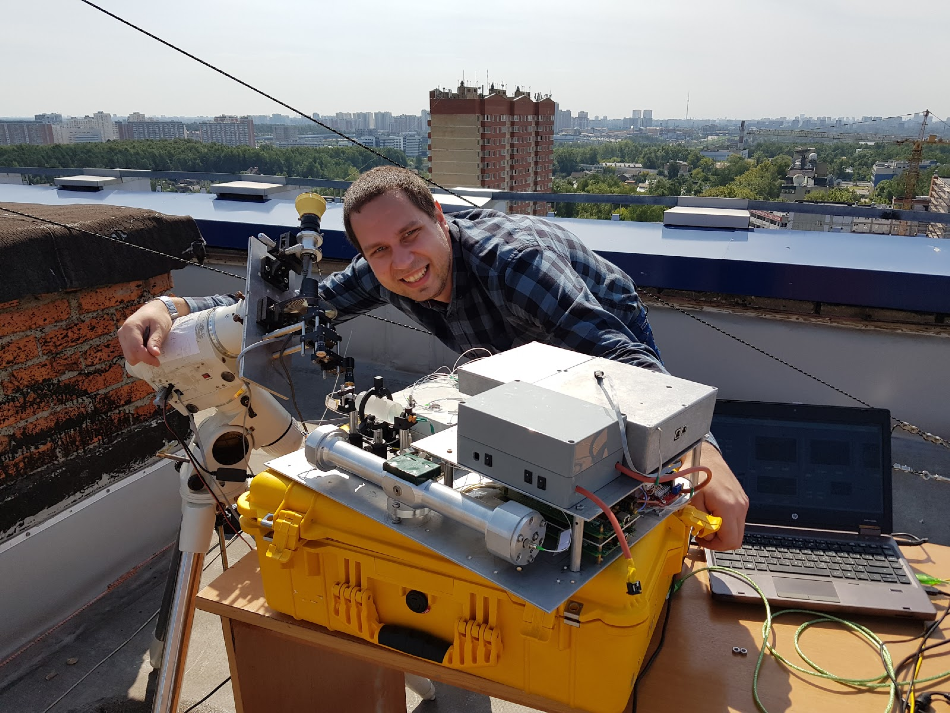Jun 11 2020
At the Moscow Institute of Physics and Technology, physicists have devised a novel technique for measuring the speed of wind remotely. This technique may complement the extensively used radar and lidar sensing methods. The study was published in the Atmospheric Measurement Techniques journal.
 Graduate student Sergei Zenevich, a co-author of the study, is setting up a heterodyne spectrometer for observations on the roof of the Applied Mathematics Building of the Moscow Institute of Physics and Technology. Image Credit: Alexander Rodin/ Moscow Institute of Physics and Technology.
Graduate student Sergei Zenevich, a co-author of the study, is setting up a heterodyne spectrometer for observations on the roof of the Applied Mathematics Building of the Moscow Institute of Physics and Technology. Image Credit: Alexander Rodin/ Moscow Institute of Physics and Technology.
A majority of the applications require wind speed measurements. For instance, it is important to assimilate these data to tweak meteorological and climatological models, like those used for predicting weather conditions.
But in spite of the advancements made in the remote sensing field across recent years, quantifying the movement of air masses continues to pose a problem. A majority of the data are obtained through conventional contact techniques: through sensors deployed to sounding balloons or weather stations.
Sonar anemometers or lidar anemometers are often employed for local measurements ranging at distances of many hundred meters or less. There are also weather radars that can assist at distances of around tens of kilometers.
But the latter are usually ineffective beyond the troposphere—the closest atmospheric layer of the Earth with a thickness of 10 to 18 km. The use of satellites for direct measurements of the movement of air masses is rather rare, and only intermittent experiments have been carried out.
Information on atmospheric dynamics is still fairly hard to obtain through direct observations. As of today, the most reliable way to remotely measure wind speeds is using Doppler radars. This technique involves sounding the environment with a powerful source of radiation and therefore takes considerable resources, including power, equipment mass, size, and cost.
Alexander Rodin, Study Lead Author and Head, Applied Infrared Spectroscopy Lab, Moscow Institute of Physics and Technology
Rodin continued, “Our instrument offers an advantage in terms of these parameters: It’s compact, inexpensive, and involves commercial components available in the telecom market.”
The new instrument is built on the principle of heterodyne detection, which is currently active in several radio engineering applications. But it must be noted that the instrument works in the optical, or more precisely, in the near-infrared range—at a wavelength of 1.65 µm.
The operating principle of the instrument is based on integrating an etalon source (local oscillator), such as a tunable diode laser, and the received signal (solar radiation, in this case, that has traveled through the air).
The laws of electromagnetic wave propagation are known to be the same for all spectral ranges; hence, the principle of heterodyning is similarly relevant to both infrared radiation and radio signals.
However, when heterodyning is applied to the optical range, it encounters certain challenges. For example, the wavefronts should match very precisely because displacement by even a fraction of a wavelength is not acceptable. The researchers from the Moscow Institute of Physics and Technology used a simple solution by applying a single-mode optical fiber.
An additional challenge is to ensure that the local oscillator has extremely accurate frequency control with an error of just 1 MHz—an insignificant quantity when compared to the optical radiation frequency. To deal with this problem, the researchers had to use an ingenious method and explore more deeply into the diode laser emission processes.
Such efforts have led to a novel instrument—an experimental laser heterodyne spectroradiometer—defined by an unparalleled spectral resolution in the near-infrared range.
This instrument quantifies the infrared atmospheric absorption spectrum with an ultra-high spectral resolution, rendering it viable to retrieve the speeds of wind with a precision of 3 to 5 m per second.
Building an instrument, even with record characteristics, is only half of the story. To retrieve wind speed at various altitudes up to the stratosphere using the measured spectra, you need a special algorithm that solves the inverse problem.
Alexander Rodin, Study Lead Author and Head, Applied Infrared Spectroscopy Lab, Moscow Institute of Physics and Technology
“We decided not to use machine learning but to implement a classical approach based on Tikhonov regularization. Despite the fact that this method is known for more than half a century, it is widely used all over the world, and its capabilities are far from being exhausted,” insisted the researcher.
The calculations will allow the retrieval of vertical wind profiles from the surface of up to 50 km. On the basis of the comparatively affordable and simple spectroradiometer, widespread networks for atmospheric monitoring can be created in the days to come.
The Applied Infrared Spectroscopy Lab at Moscow Institute of Physics and Technology is planning to perform an observational campaign to quantify the stratosphere polar vortex and also the concentration of greenhouse gas in the Russian Arctic with their recently created instrument.
In association with the Space Research Institute of the Russian Academy of Sciences, the laboratory is also creating an instrument to analyze the atmosphere of Venus based on the same kind of principle. The instrument is likely to be set up onboard India’s Venus orbiter in the context of international cooperation.
While developing their innovative instrument, the researchers at Moscow Institute of Physics and Technology were joined by collaborators from the Space Research Institute and Prokhorov General Physics Institute of the Russian Academy of Sciences, and Samsung R&D Institute Russia.
The Russian Foundation for Basic Research has funded the study.
Journal Reference:
Rodin, A. V., et al. (2020) Vertical wind profiling from the troposphere to the lower mesosphere based on high-resolution heterodyne near-infrared spectroradiometry. Atmospheric Measurement Techniques. doi.org/10.5194/amt-13-2299-2020.